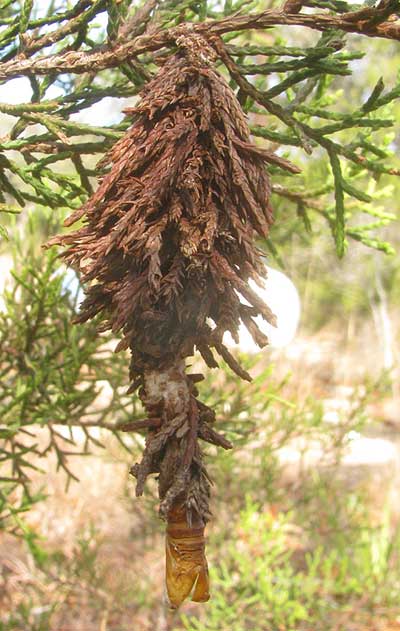Excerpts from Jim Conrad's
Naturalist Newsletter
from the February 9, 2014 Newsletter issued from the Frio Canyon Nature Education Center in the valley of the Dry Frio River in northern Uvalde County, southwestern Texas, on the southern border of the Edwards Plateau; elevation ~1750m (~5750 ft); N29.62°, W99.86°; USA
BAGWORM STORIES
Nowadays on a leafless branch of Netleaf Hackberry in the Dry Frio's cobblestone floodplain there hangs a bagworm cocoon, shown below:

Also at this moment, on an Ashe Juniper branch beside Juniper House, there's the cocoon shown below:

Notice that at the bottom of the last cocoon the bag becomes narrow and long, and at the very bottom there's an amber-colored, cellophane-like "exuvia," an exuvia being the remains of a molted arthropod such as an insect. Comparing the two cocoons, questions arise, and in answering them, stories about the bagworm's life history form in our minds.
Many different kinds of bagworms exist, at least if by the term "bagworm" we're referring to the caterpillar stage of a species of moth belonging to the Bagworm Moth Family, the Psychidae, of which about 1350 species are known. Many of those species produce cocoons very different from the ones in our pictures. The bagworm known by people in the US from New England and Nebraska south and throughout Texas is THYRIDOPTERYX EPHEMERAEFORMIS, which probably produced the cocoons in our pictures. That species places its cocoons on a variety of plants, especially evergreens but also deciduous trees, adorning the cocoon's exterior with items gathered around the cocoon site, so that accounts for our cocoons bearing different coverings.
To understand what the bags are about, and why extra stuff might appear at the bottom of one but not the other, we can take a look at the life cycle of Thyridopteryx ephemeraeformis:
In the spring, inside an overwintered cocoon, tiny, caterpillar-type larvae emerge from eggs inside the body of their mother, who has been dead since the previous fall. Emerging from the cocoon's bottom, the caterpillars drop down on a strand of silk, the wind often blowing them to neighboring plants. Once a caterpillar is settled on a good host plant, it begins building its own cocoon from silk and fecal material, over the weeks gradually adding leaves and twigs to the growing cocoon's exterior; this camouflages the cocoon and adds a bit of armor. During this time the growing caterpillar feeds voraciously, and if there are enough of them they can damage a plant or even kill it. The caterpillar moves about on legs at its front end, which protrude through its cocoons.
In late summer when the caterpillar reaches its largest size -- its last instar -- it wraps silk around a branch, dangles from it, and pupates head down. Adult males metamorphose into moths in four weeks, and fly away looking for females, but the females never leave their cocoons. This situation is met by the male mating with her through the open end at the bottom of her cocoon. The poor female is hardly more than a baby-producing machine. She has no eyes, legs, wings, antennae, and can't eat. She just mates and dies. After her death with hundreds to thousands of eggs inside her, her offspring hatch, and over a period of several months pass through her body, pupal shell and cocoon, finally dropping from the cocoon on silk lines, and starting the cycle all over again.
So, I'll bet that inside the cocoon with no extension at its bottom there's a dead female filled with eggs and/or developing larvae. The cocoon with the amber exuvia protruding through a hole at its bottom is that of a male who in the fall went looking for a female.
And that's how you learn the story behind a bag hanging on a tree.